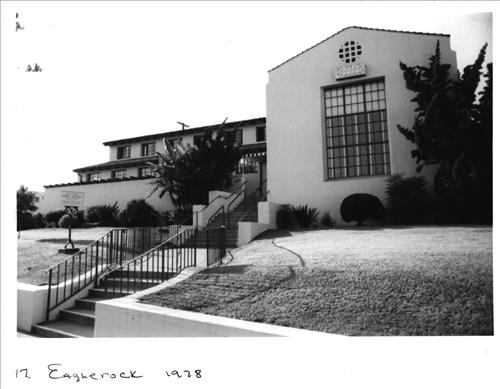The Eagle Rock Branch Library is significant for its cultural role in the development of the Eagle Rock community, as part of the nation's largest branch library system, and as a notable example of public architecture, designed by architects Henry C. Newton and Robert D. Murray.
The library had its beginning in 1914, when a group of Eagle Rock citizens concerned about the need for a library met and decided to write the Carnegie Foundation and request that a library be established in the City. The foundation responded by providing a grant of $7,500 to the City of Eagle Rock. A lot on Colorado near Eagle Rock Boulevard adjacent to the commercial center was purchased. W. E. Kleinspell was chosen from among several architects to design the new library, and he chose the popular Mission Revival style for Eagle Rock's first library.
The library was a center of the community from its earliest days, patronized by a large segment of the Eagle Rock populace. It had displays of the numerous Rose Parade awards won by the City of Eagle Rock, and the children's room displayed artwork by the local school children.
In 1923, the City of Eagle Rock was incorporated into the City of Los Angeles and the library became a branch of the Los Angeles system. The library continued to be one of the most heavily used and, in 1927, plans were formalized to expand the library building.
Architects Henry C. Newton and Robert D. Murray were chosen to redesign the building in 1927. They incorporated an ecclesiastical scheme into the building and remodeled its exterior in the Spanish style. The new building featured a cruciform plan, unusual for a library, with a central reading room (the nave) flanked by bookshelf areas. The architects added an additional roof so that light would illuminate the reading room through clerestory windows. The reading room featured a series of arches with cast stone columns set between it and the side, bookshelf areas. A ceiling with wood trusses was the distinctive feature on the interior. An unusual part of the remodeling was the creation of an outdoor reading area on the rear roof of the building.
The architectural team of Newton and Murray were prominent local architects who specialized in ecclesiastical designs. Some of their important commissions include the Church of the Precious Blood in the Mid-Wilshire area, Saint Peter and Paul Church in Wilmington, Saint Paul the Apostle Church in West Los Angeles and the La Canada Thursday Club Building.
The building remains an important link to the early years of the Eagle Rock community. It has a prominent location and siting which reinforces its significance as a public building; it maintains its strong sense of time and place. It is part of a thematic grouping of Los Angeles Branch Libraries which has been nominated to the National Register of Historic Places.

